Aune X1S – the stylish beast
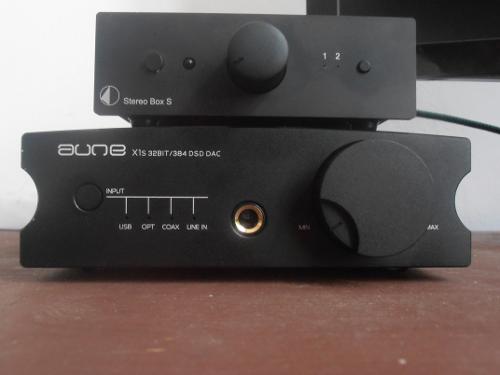
Disclaimer:
I was provided with a loaner unit as part of Aune's review tour. I got to keep the X1S for seven days until I had to send it to Italy. Neither do I work for Aune nor have I any afiliation with this company.
So thank you Aune for including me in your tour!
Introduction:
Honestly, at first I struggled to decide if I wanted to apply to Aune's tour. But in the end I made up my mind and I'm very glad I did. The X1S is an amazing versitable DAC with quite a few inputs (optical, coaxial, USB, line in) for its size and most of all it has an incredible sound!
I connected the DAC to my computer using an Audioquest Forrest USB cable and sending the Line Out signal to my Stereo Box S made by Pro-Ject which fed my speakers (Speaker Box 5, also Pro-Ject).
Setup:
PC (Linux, mpd) → X1S → Stereo Box S → Speaker Box 5
AK 100ii (opt) → X1S → Stereo Box S → Speaker Box 5
FiiO X5ii (coax) → X1S → Stereo Box S → Speaker Box 5
PC (Linux, mpd) → X1S → Final Audio Design – Pandora Hope VI
PC (Linux, mpd) → X1S → AKG K240 (Sextett, 600 Ohms)
Package and Content:
The very first thing I noticed when I opened the delivery box was Aune's logo. An ambigram, I love those things! Did put a wide grin on my chin. I know, not audio related, but still...
The box itself is kept in a simple black design with their logo on top. In it you'll find the DAC itself, the (huge) power chord, a warranty card, a USB stick containing the manual, a mini stereo jack adapter and a USB cable to connect the DAC to the computer.
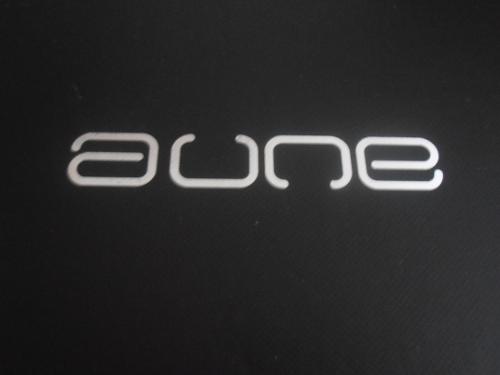

Everything sits in the box well secured in its own little chamber.
The charger brick is massive to say the least, quite heavy too, but it did get stored behind my desk where it didn't bother me, and besides, it's about the DAC.


The X1S for the european tour looks stunning, I like the black version better than the white one. It is a real beauty.
It looks like it's build to last, very solid and robust design. What do you want more?
Usage:
On the back are all the available inputs (USB, coaxial, optical, Line In) plus two RCAs for line out and coaxial out. I have read that a few people complained that the volume is fixed via line out, this didn't bother me at all since I connected the device to my amplifier.

On the front plate you will find the LED indicators which tell you what input's currently in use. You can switch inputs by pressing the button on the left.
It also supports three different filter settings (fast roll off, slow roll off and minimum phase) which can be set by long pressing the input button. Once the LED turns red you can pick your preferred filter.
On the front there's also a headphone jack and the volume control for it.

Most of us might connect the X1S up to the computer for main usage, and so did I, unfortunately I encountered a little hick up: I often had to unplug and replug in the USB cable because my computer did not recognize the DAC. Could have been because I didn't use the stock USB cable (don't think so) or because I use Linux (would surprise me too). But this happened a few times in a row actually. Nothing too big, but still annoying.
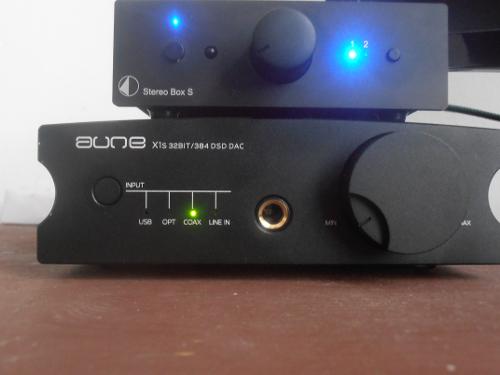
For best possible sound make sure to get a bitperfect playback. Disabling pulseaudio and using mpd with Linux helps a lot and improves the sound massively. Take my word for it.
Sound:
The X1S uses the mobile version of the phenomenal ES9018 the ES9018K2M as DAC chip, it decodes files with samplings up to 384kHz/32bit and does native DSD playback up to DSD128. So on paper this is an astounding piece of hardware. The question is how does it behave in practice. Simple answer to that: nothing less than perfect!
Its soundstage is huge, depth is amazing and the detail is simply overwhelming. Never have my speaker put out a sound like this. Fascinating.
Every song I played through the Aune was clean, clear and natural. I found myself changing tracks and genres rapidly at one point, simply because I wanted to know how it sounds. I couldn't wait to hear what the X1S had to say. Jazz – amazing trumpets and super realistic bass. Rock – so much energy, infectious. Electronic (IDM) – insane detail and instrumental separation. Orchestral music – wonderful strings, every high hat crush sounded super natural. Needless to say: I loved it.
To me it is dead neutral, no coloring added. This is the sound of the sound. Pure.
One of my most loved tunes (Björk's Lionsong) sounded especially great, her voice so clean and with wonderful body, bass went deep and smooth, I could almost feel the strings.
This DAC pushed watching movies and TV-shows to a new level. Its amazing depth revealed an experience I've never had before. Suddenly everything became more three dimensional, imaging was easier and of course everything became more life like and realistic.
I used two pairs of headphones for this review, the Pandora Hope VI (8 ohms) by Final Audio Design and a vintage K240 (600 ohms, original Sextett, made in the 70's) by AKG.
The Pandora is an easy to drive headphone which is used on a daily basis, and it became my reference can over time. The X1S had absolutely no problem driving them of course. Like my desktop setup, the headphones sounded insanely great! Wonderful soundstage, image, separation and also very natural and neutral.
As always when it comes down to testing the power capabilities I take out my AKG K240. At 600 ohms they are a lot more difficult to drive. So when I plugged them into the headphone out of the X1S I was impressed with how much authority they were driven. The in total 12 passive radiators and both 32mm drivers were pushed to their best and out came a sound of pure happiness. Never have they been touched like that since I got them, never have I gotten to hear them sound like that.
Conclusion:
Sound as its supposed to be, great input selection plus a very PC desktop friendly size make it very easy to fall in love with this DAC.
For 249$ this is a no brainer. Take it and enjoy it.
Final Words:
I'd like to thank Aune for making this tour possible and for including me. Also I would like to say thank you to @reiserFS for everything he had to put up with, to even get the unit to Europe! If it wasn't for him the X1S might still be in delivery somewhere.
It was a short but very welcome time.
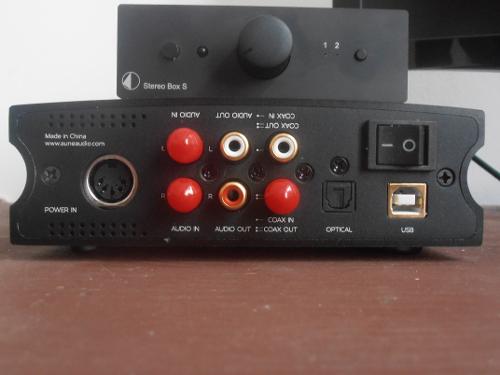
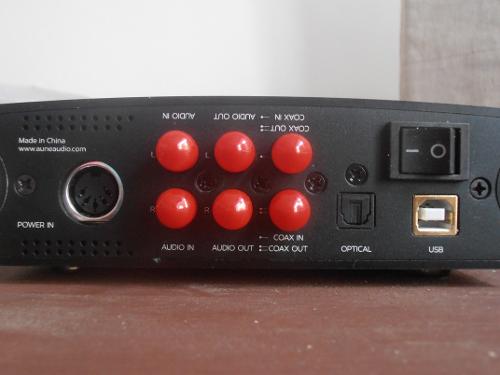


Disclaimer:
I was provided with a loaner unit as part of Aune's review tour. I got to keep the X1S for seven days until I had to send it to Italy. Neither do I work for Aune nor have I any afiliation with this company.
So thank you Aune for including me in your tour!
Introduction:
Honestly, at first I struggled to decide if I wanted to apply to Aune's tour. But in the end I made up my mind and I'm very glad I did. The X1S is an amazing versitable DAC with quite a few inputs (optical, coaxial, USB, line in) for its size and most of all it has an incredible sound!
I connected the DAC to my computer using an Audioquest Forrest USB cable and sending the Line Out signal to my Stereo Box S made by Pro-Ject which fed my speakers (Speaker Box 5, also Pro-Ject).
Setup:
PC (Linux, mpd) → X1S → Stereo Box S → Speaker Box 5
AK 100ii (opt) → X1S → Stereo Box S → Speaker Box 5
FiiO X5ii (coax) → X1S → Stereo Box S → Speaker Box 5
PC (Linux, mpd) → X1S → Final Audio Design – Pandora Hope VI
PC (Linux, mpd) → X1S → AKG K240 (Sextett, 600 Ohms)
Package and Content:
The very first thing I noticed when I opened the delivery box was Aune's logo. An ambigram, I love those things! Did put a wide grin on my chin. I know, not audio related, but still...
The box itself is kept in a simple black design with their logo on top. In it you'll find the DAC itself, the (huge) power chord, a warranty card, a USB stick containing the manual, a mini stereo jack adapter and a USB cable to connect the DAC to the computer.


Everything sits in the box well secured in its own little chamber.
The charger brick is massive to say the least, quite heavy too, but it did get stored behind my desk where it didn't bother me, and besides, it's about the DAC.


The X1S for the european tour looks stunning, I like the black version better than the white one. It is a real beauty.
It looks like it's build to last, very solid and robust design. What do you want more?
Usage:
On the back are all the available inputs (USB, coaxial, optical, Line In) plus two RCAs for line out and coaxial out. I have read that a few people complained that the volume is fixed via line out, this didn't bother me at all since I connected the device to my amplifier.

On the front plate you will find the LED indicators which tell you what input's currently in use. You can switch inputs by pressing the button on the left.
It also supports three different filter settings (fast roll off, slow roll off and minimum phase) which can be set by long pressing the input button. Once the LED turns red you can pick your preferred filter.
On the front there's also a headphone jack and the volume control for it.

Most of us might connect the X1S up to the computer for main usage, and so did I, unfortunately I encountered a little hick up: I often had to unplug and replug in the USB cable because my computer did not recognize the DAC. Could have been because I didn't use the stock USB cable (don't think so) or because I use Linux (would surprise me too). But this happened a few times in a row actually. Nothing too big, but still annoying.

For best possible sound make sure to get a bitperfect playback. Disabling pulseaudio and using mpd with Linux helps a lot and improves the sound massively. Take my word for it.
Sound:
The X1S uses the mobile version of the phenomenal ES9018 the ES9018K2M as DAC chip, it decodes files with samplings up to 384kHz/32bit and does native DSD playback up to DSD128. So on paper this is an astounding piece of hardware. The question is how does it behave in practice. Simple answer to that: nothing less than perfect!
Its soundstage is huge, depth is amazing and the detail is simply overwhelming. Never have my speaker put out a sound like this. Fascinating.
Every song I played through the Aune was clean, clear and natural. I found myself changing tracks and genres rapidly at one point, simply because I wanted to know how it sounds. I couldn't wait to hear what the X1S had to say. Jazz – amazing trumpets and super realistic bass. Rock – so much energy, infectious. Electronic (IDM) – insane detail and instrumental separation. Orchestral music – wonderful strings, every high hat crush sounded super natural. Needless to say: I loved it.
To me it is dead neutral, no coloring added. This is the sound of the sound. Pure.
One of my most loved tunes (Björk's Lionsong) sounded especially great, her voice so clean and with wonderful body, bass went deep and smooth, I could almost feel the strings.
This DAC pushed watching movies and TV-shows to a new level. Its amazing depth revealed an experience I've never had before. Suddenly everything became more three dimensional, imaging was easier and of course everything became more life like and realistic.
I used two pairs of headphones for this review, the Pandora Hope VI (8 ohms) by Final Audio Design and a vintage K240 (600 ohms, original Sextett, made in the 70's) by AKG.
The Pandora is an easy to drive headphone which is used on a daily basis, and it became my reference can over time. The X1S had absolutely no problem driving them of course. Like my desktop setup, the headphones sounded insanely great! Wonderful soundstage, image, separation and also very natural and neutral.
As always when it comes down to testing the power capabilities I take out my AKG K240. At 600 ohms they are a lot more difficult to drive. So when I plugged them into the headphone out of the X1S I was impressed with how much authority they were driven. The in total 12 passive radiators and both 32mm drivers were pushed to their best and out came a sound of pure happiness. Never have they been touched like that since I got them, never have I gotten to hear them sound like that.
Conclusion:
Sound as its supposed to be, great input selection plus a very PC desktop friendly size make it very easy to fall in love with this DAC.
For 249$ this is a no brainer. Take it and enjoy it.
Final Words:
I'd like to thank Aune for making this tour possible and for including me. Also I would like to say thank you to @reiserFS for everything he had to put up with, to even get the unit to Europe! If it wasn't for him the X1S might still be in delivery somewhere.
It was a short but very welcome time.


















 I never had the opportunity to listen to the Yggdrasil, or the Chord Hugo either. NYC has surprisingly fewer choices for top tier demo-ing than one might expect
I never had the opportunity to listen to the Yggdrasil, or the Chord Hugo either. NYC has surprisingly fewer choices for top tier demo-ing than one might expect 
































































![DSC_1314[1].jpg DSC_1314[1].jpg](https://cdn.head-fi.org/a/10060130_thumb.jpg)


















































































